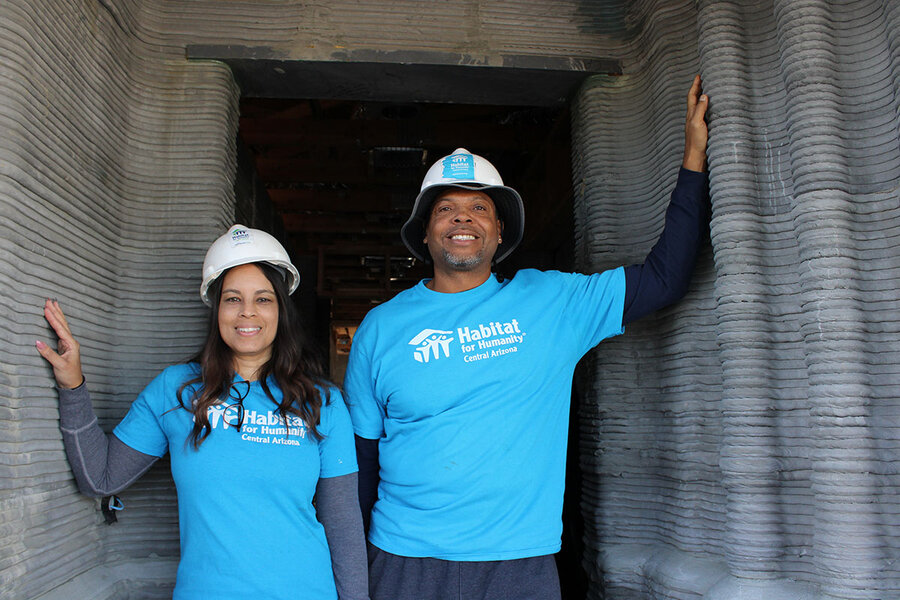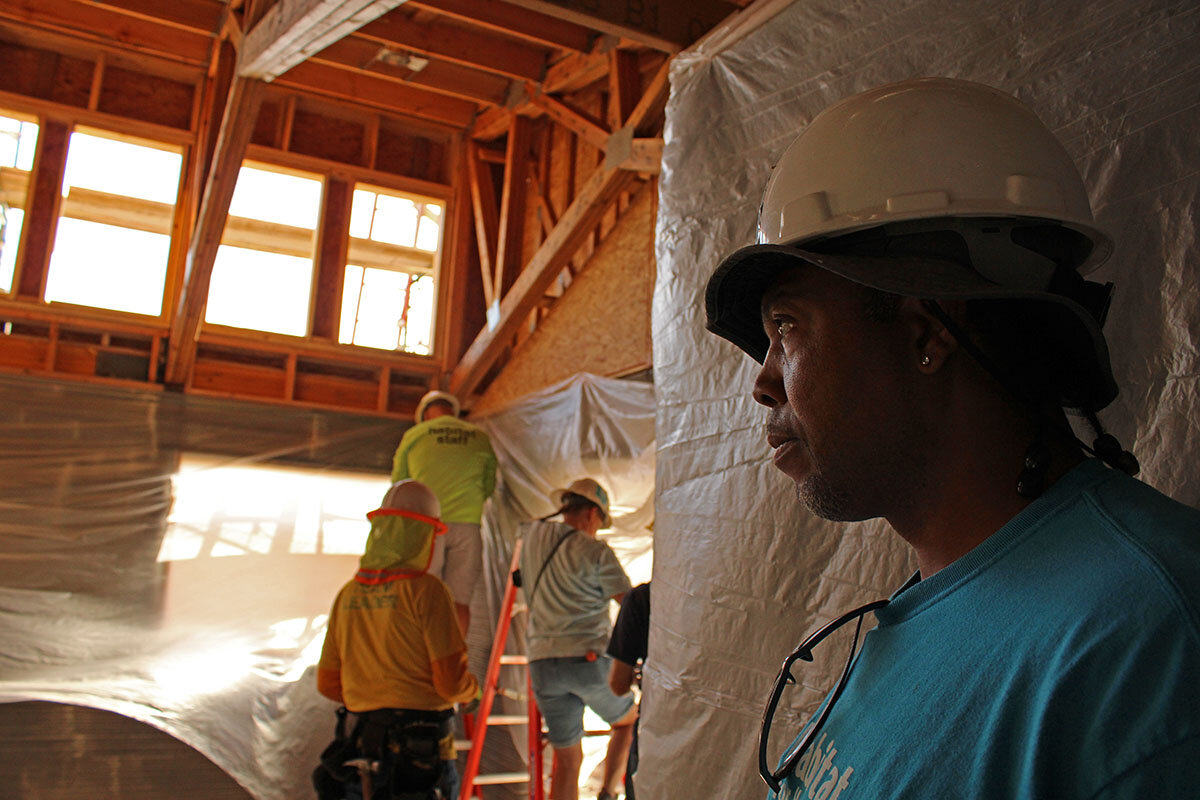Could 3D printing help solve the housing crisis?
Loading...
| Tempe, Ariz.
From a distance, the home under construction blends in with its Tempe, Arizona, neighborhood – modest residential blocks landscaped with pebbles and cactuses. The ranch-style house is even topped with a traditional wood-frame roof, hiding a surprise below.
Earlier this year, a massive printer oozed out row upon row of gray, toothpastelike ribbons of mortar that have hardened into walls. The site is considered the first 3D-printed home created by a U.S. affiliate of Habitat for Humanity, the global affordable-housing nonprofit.
“This is such a unique house,” says future owner Shawn Shivers, sporting a hard hat on-site.
Why We Wrote This
Sometimes solutions turn up in surprising places. Once beyond its infancy, 3D-printed construction could win the favor of builders, homebuyers, and even environmentalists.
Advocates say 3D-printed homes could provide what the Shivers family seeks: affordable housing. As with any new industry, there are growing pains, of course, including issues of regulation and sustainability. But as the Tempe team knows well, it takes patience to print a path to progress.
Early promise
Guns, burgers, artificial joints – a range of improbable objects have become printable since the 1980s. Even NASA is planning for 3D-printed habitats beyond Earth. In recent years, 3D-printed construction, an example of additive manufacturing, has taken off with the advancement of software, materials, and machinery.
Though unlikely to go mainstream in the near-future, according to Guidehouse Insights, “after years of R&D, the market is nearing a tipping point as companies are moving beyond pilots and demonstration projects to selling their products.”
Multiple firms in the United States are building 3D-printed homes. Tech startup ICON claims to have built the first permitted 3D-printed home in the country in 2018 in Texas. SQ4D, another construction technology company, boasts that it listed the first 3D-printed home for sale in the U.S. this year (in New York for $299,999). The tech has gone global, from rural Mexico to the United Arab Emirates. PERI 3D Construction, overseen by a German parent company, supplied a gantry-style BOD2 printer to the Tempe project.
Typically, the building design is exported into a computer program where the 3D geometry of the structure is sliced into layers. Code commands plot the path of the nozzled machine – directing it from point A to B, fast or slow, straight line or arc.
Unbound by traditional building restrictions, 3D-printing allows for more creative freedom in architecture, says Michael Maughan, assistant professor of mechanical engineering at the University of Idaho.
“The reason we make rooms square and houses as boxes is because that’s efficient, and it’s what’s been done before,” says Dr. Maughan, suggesting a future with more unique building designs.
Advocates point to other benefits like speedier on-site construction, less waste, and reduced labor. All could lower building costs – an attractive goal, given the pandemic context:
- Though prices for building materials decreased slightly in September, they’re still 13.9% higher than 12 months earlier, according to an analysis of federal data by the National Association of Homebuilders.
- Faced with a hot housing market, the construction industry may need more than a million additional workers over the next two years, estimates Associated Builders and Contractors.
- Demand for affordable housing persists. In Arizona, single-family home prices skyrocketed 22.7% between May 2020 and May 2021, a Move analysis of Zillow data found.
Learning curves
Habitat for Humanity Central Arizona, an affiliate of the global nonprofit, estimates that around 70% of its innovative Tempe home will end up printed.
One October morning, Mrs. Shivers and husband Marcus Shivers traipse past the corrugated walls of their custom home-to-be, envisioning bar stools here, a ceiling fan there. They’re eager to move in. Before they’re handed the key, they will have volunteered at least 400 hours of “sweat equity.”
“For me it’s everything, ‘cause I’m more of a hands-on skill guy,” says Mr. Shivers, who likes learning about masonry. “I was telling someone the other day that I literally have sweat in my house.”
Mrs. Shivers conquered her fear of the nail gun. “I was just so scared of it at first … but now I’m like – kchh-kchh,” she says, miming with her hand. “I’m like, pro now.”
The high school sweethearts met at a basketball game a couple of blocks from their new digs. They love Tempe – a college town punctuated by palms – and committed to stay, even as prices began to rise. They say their estimated mortgage repayments to Habitat for the three-bedroom house will be about $100 cheaper than rent on their current two-bedroom apartment.
How well their home lives up to 3D-printing’s vaunted promises remains to be seen. The nonprofit won’t know the total cost, build time, or waste until after completion.
Habitat expected the prototype to take longer than usual projects, and it has: half a year versus a traditional 16- to 20-week build. Pandemic aside, supply chain issues have thrown a wrench in the works, like delays with foam insulation and windows, says chief operating officer Debra Bradley.
And with so many in-kind donations – from the printer to plumbing – it’s difficult to know how this home compares to Habitat’s usual stick-built houses in the area. Those typically cost around $200,000, a price tag the Shivers’ place has already surpassed. Major additional expenses, says Ms. Bradley, resulted from a regulatory wrinkle.
The City of Tempe, which sold the land to Habitat for around $10, follows the widely used 2018 International Residential Code. Since that version of the code doesn’t address 3D-printing directly, Habitat had to invest in additional structural design before the house could obtain necessary permits.
“We really want to look at innovation as a solution for this affordable housing crisis here in Arizona that can be replicated elsewhere ... but we really believe that it’s got to start with that building code,” says Ms. Bradley.
Such growing pains for a new field are expected, say industry experts.
“We’re trying to do something that’s never been done before, and it doesn’t sit well within the existing system,” says Dr. Maughan at the University of Idaho. “Even small changes to materials and processes – they take a long time to implement in this industry.”
Sustainability is another concern. Many 3D construction firms rely on cement, the production of which accounts for around 8% of global carbon dioxide emissions.
That’s why Dr. Maughan is tapping into the potential of renewable materials, which might also be a cheaper alternative. His team is exploring how to combine wood waste with a binding agent for use in 3D-printed construction. Likely a few years away from market, he says, it could be a “huge game changer.”
The private sector is weighing in, too. Mighty Buildings, a California construction technology company, plans to use a cement alternative by partner Fortera that cuts CO2 emissions by over 60% for each cement ton replaced. This supports Mighty Buildings’ pledge to become carbon-neutral by 2028.
In Tempe, the Shivers expect to move in early next year. He can’t wait to grill. She can’t wait to run a rug the length of their long hallway.
Also: “Figure out how we’re going to hang things on the walls,” she says. “’Cause they’re all cement.”








